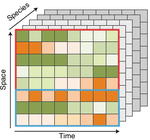Abstract
Species distributions and abundances are undergoing rapid changes worldwide. This highlights the significance of reliable, integrated information for guiding and assessing actions and policies aimed at managing and sustaining the many functions and benefits of species.
Here we synthesize the types of data and approaches that are required to achieve such an integration and conceptualize ‘essential biodiversity variables’ (EBVs) for a unified global capture of species populations in space and time. The inherent heterogeneity and sparseness of raw biodiversity data are overcome by the use of models and remotely sensed covariates to inform predictions that are contiguous in space and time and global in extent. We define the species population EBVs as a space–time–species–gram (cube) that simultaneously addresses the distribution or abundance of multiple species, with its resolution adjusted to represent available evidence and acceptable levels of uncertainty.
This essential information enables the monitoring of single or aggregate spatial or taxonomic units at scales relevant to research and decision-making. When combined with ancillary environmental or species data, this fundamental species population information directly underpins a range of biodiversity and ecosystem function indicators. The unified concept we present links disparate data to downstream uses and informs a vision for species population monitoring in which data collection is closely integrated with models and infrastructure to support effective biodiversity assessment.
